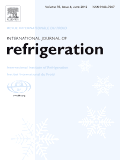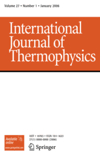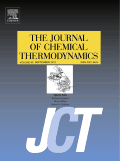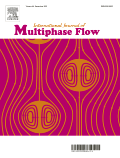
FLUID PHASE EQUILIBRIA
metrics 2024
Bridging Theory and Application in Fluid Studies
Introduction
FLUID PHASE EQUILIBRIA, published by Elsevier, stands as a pivotal platform within the realm of chemical engineering and physical chemistry since its inception in 1977. With an ISSN of 0378-3812 and an E-ISSN of 1879-0224, this esteemed journal features a diverse array of research dedicated to the principles and applications of phase equilibria in fluid systems. Ranked within the top quartiles (Q2) across multiple categories, including Chemical Engineering and Physical and Theoretical Chemistry, it highlights its significance with Scopus ranks that place it prominently in comparison to its peers. Although it does not currently offer open access, the journal's extensive content contributes significantly to scholarly discourse, making it an invaluable resource for researchers, professionals, and students alike. Operating from Amsterdam, Netherlands, FLUID PHASE EQUILIBRIA serves as a central hub for advancing knowledge and fostering collaboration in fluid phase studies, promising insights that span theoretical analyses to practical implementations.
Metrics 2024
 0.57
0.57 2.80
2.80 2.50
2.50 138
138Metrics History
Rank 2024
Scopus
IF (Web Of Science)
JCI (Web Of Science)
Quartile History
Similar Journals

INTERNATIONAL JOURNAL OF REFRIGERATION
Fostering interdisciplinary dialogue in cooling technologies.International Journal of Refrigeration, published by Elsevier Science Ltd, is a leading periodical dedicated to advancing the field of refrigeration and its applications. With an impressive impact factor and ranking in the top quartile (Q1) of both Building and Construction and Mechanical Engineering categories, this journal has been instrumental in disseminating innovative research and breakthroughs since its inception in 1978. Covering a vast array of topics related to refrigeration technology, thermodynamics, and energy efficiency, it serves as an essential resource for researchers, engineers, and students alike. By providing high-quality, peer-reviewed articles, it aims to foster interdisciplinary dialogue and contribute significantly to the development of sustainable practices in the refrigeration sector. Although the journal does not offer open access options at present, its rigorous publication standards ensure that the latest advancements reach a broad audience in the academic and professional communities.

INTERNATIONAL JOURNAL OF THERMOPHYSICS
Advancing Knowledge in Thermophysical ApplicationsInternational Journal of Thermophysics, published by Springer/Plenum Publishers, is a premier platform for the dissemination of high-quality research in the field of thermophysics, particularly focusing on the intricate relationships between thermal properties and their applications across various scientific disciplines. With an ISSN of 0195-928X and an E-ISSN of 1572-9567, the journal has established a respected presence in the academic community since its inception in 1980, with a converged publication timeline extending to 2024. Categorized in the Q2 quartile for Condensed Matter Physics in 2023 and maintaining impressive Scopus rankings—such as #39 in Fluid Flow and Transfer Processes and #178 in Condensed Matter Physics—the journal serves as a vital resource for researchers and professionals aiming to advance knowledge in the thermal sciences. Though not an open-access journal, it remains accessible through institutional subscriptions. The International Journal of Thermophysics is committed to fostering innovative research and interdisciplinary collaboration, ensuring that it remains at the forefront of thermophysical studies.

Journal of Applied Mechanics and Technical Physics
Innovating Insights in Applied Mechanics and Technical PhysicsJournal of Applied Mechanics and Technical Physics is a distinguished publication that serves as a vital resource for researchers and professionals in the realms of mechanical engineering, mechanics of materials, and condensed matter physics. Published by MAIK NAUKA/INTERPERIODICA/SPRINGER, this journal has been committed to disseminating high-quality research since its inception in 1965. With a noted presence in the academic community, it holds a respectable Q3 ranking in multiple categories as of 2023, indicating its relevance and contribution to the field. Although it does not currently offer open access, the journal provides valuable insights and advancements through its rigorous peer-review process. Covering a broad spectrum of topics in applied mechanics and technical physics, it aims to foster innovation and dialogue among scientists, engineers, and scholars alike. Located in the United States, the journal continues to make significant strides in bridging the gap between theoretical research and practical applications, making it an essential read for anyone engaged in these dynamic fields.

Russian Journal of Physical Chemistry A
Elevating the Standards of Chemistry ScholarshipWelcome to the Russian Journal of Physical Chemistry A, a prominent publication in the field of Physical and Theoretical Chemistry, published by MAIK NAUKA/INTERPERIODICA/SPRINGER. This journal, with ISSN 0036-0244 and E-ISSN 1531-863X, has been a vital platform for disseminating significant research findings since its inception in 1996. As a key contributor to academic discourse, it aims to provide high-quality articles that explore fundamental and applied aspects of physical chemistry, thereby enhancing understanding and innovation in the discipline. Although currently categorized as Q4 by Scopus (2023), the journal is positioned to evolve with the scholarly landscape, continually striving to improve its impact and relevance. With no open access options available, subscription to this journal is essential for those keen on enriching their knowledge and staying current with advancements in physical chemistry. Researchers, professionals, and students alike will find invaluable insights and robust discussions that can inspire their work and studies.

Archives of Thermodynamics
Pioneering Research in Thermodynamic SystemsArchives of Thermodynamics is a reputable journal dedicated to the field of thermodynamics, published by the esteemed POLISH ACADEMY OF SCIENCES. With a robust history since its inception in 2003, this journal serves as a critical platform for disseminating high-quality research aimed at advancing knowledge and technology in thermodynamic systems and processes. Recognized for its contribution to the field, it holds a Q3 ranking in the Physics and Astronomy (miscellaneous) category as of 2023, with a respectable Scopus rank of #148 out of 243, placing it within the 39th percentile. Although it follows a traditional access model, the journal's commitment to scholarly excellence ensures that researchers, professionals, and students alike can benefit from its rich archives and ongoing discussions within the scientific community. Situated in Warsaw, Poland, the journal not only reflects a regional dedication to scientific progress, but also engages with global audiences interested in the evolving landscape of thermodynamic research.

JOURNAL OF CHEMICAL THERMODYNAMICS
Illuminating the Path of Thermodynamic ResearchThe JOURNAL OF CHEMICAL THERMODYNAMICS serves as a pivotal platform for the dissemination of high-quality research in the field of thermodynamics and its applications across various scientific disciplines. Published by Academic Press Ltd - Elsevier Science Ltd, this esteemed journal, with an ISSN of 0021-9614 and E-ISSN 1096-3626, strives to contribute to the understanding of the thermodynamic properties of chemicals, materials, and molecular interactions. Covering a broad spectrum of topics from atomic and molecular physics to general materials science, it consistently ranks in the Q2 category across multiple fields including Physics and Astronomy, Chemistry, and Materials Science. With its convergence years extending from 1969 to 2025, the journal boasts a respected history and a commitment to fostering scholarly dialogue among researchers, professionals, and students alike. Though it is not an Open Access journal, its rigorous peer-review process ensures that published articles meet the highest standards of scientific excellence, making it an essential resource for anyone seeking to stay at the forefront of chemical thermodynamics research.

INTERNATIONAL JOURNAL OF MULTIPHASE FLOW
Pioneering Research in Multiphase FlowINTERNATIONAL JOURNAL OF MULTIPHASE FLOW, published by Pergamon-Elsevier Science Ltd, is a premier platform dedicated to the dissemination of cutting-edge research in the field of multiphase flow. With an impressive impact factor and ranking in the Q1 category across various disciplines including Fluid Flow and Transfer Processes, Mechanical Engineering, and Physics and Astronomy, this journal serves as a crucial resource for researchers and professionals aiming to advance knowledge and applications in fluid dynamics. Since its inception in 1973, the journal has established a distinguished legacy, providing a venue for high-quality research articles, comprehensive reviews, and technical notes that push the boundaries of current understanding. Although it does not offer Open Access options, its rigorous peer-review process ensures that only the most relevant and significant contributions are published, making it a vital source for students and experts alike striving for excellence in their fields. The journal is based in Kidlington, Oxford, United Kingdom, and continues to be a pivotal part of scholarly discourse in multiphase flow research.

RUSSIAN JOURNAL OF INORGANIC CHEMISTRY
Pioneering Research in the World of InorganicsThe Russian Journal of Inorganic Chemistry is a distinguished publication that delves into the fundamental and applied aspects of inorganic chemistry. Published by MAIK Nauka/Interperiodica/Springer, this journal has established itself as a vital resource for researchers, professionals, and students alike, contributing significantly to the fields of Inorganic Chemistry, Materials Science, and Physical and Theoretical Chemistry. With an ISSN of 0036-0236 and an E-ISSN of 1531-8613, the journal is indexed for easy access and citation. Though the journal currently operates under a subscription model, its commitment to disseminating high-quality research and fostering scientific discourse remains steadfast. The journal has been maintaining a consistent record since its inception, and its positioning in the Q3 quartile across various chemistry categories in 2023 underscores its relevance in the academic community. As it continues through its converged years from 1996 to 2024, the Russian Journal of Inorganic Chemistry plays a pivotal role in enhancing the understanding and advancement of inorganic chemistry, making it an indispensable tool for anyone engaged in this dynamic field.

TRANSPORT IN POROUS MEDIA
Transforming Understanding of Porous MediaTRANSPORT IN POROUS MEDIA is a prominent peer-reviewed journal published by Springer, dedicated to advancing the understanding of fluid and energy transport processes in porous structures. With an ISSN of 0169-3913 and an E-ISSN of 1573-1634, this journal has established itself as a leading platform in the realms of chemical engineering and catalysis, achieving a ranking of Q2 in Chemical Engineering and Q3 in Catalysis as of 2023. The journal encompasses a wide scope, covering theoretical, experimental, and applied research that explores the complexities of porous media transport phenomena, thus catering to a diverse audience of researchers, professionals, and students in related fields. Although open access options are not offered, TRANSPORT IN POROUS MEDIA remains an excellent resource for those seeking to stay at the forefront of advancements and challenges in porous media transport. With a publication history dating back to 1986 and ongoing contributions expected until 2024, this journal continues to play a crucial role in fostering knowledge and innovation within the discipline.

Journal of Superhard Materials
Advancing the frontiers of superhard materials research.The Journal of Superhard Materials, published by PLEIADES PUBLISHING INC, is a premier journal dedicated to advancing the field of superhard materials, including their synthesis, properties, and applications. With an ISSN of 1063-4576 and E-ISSN 1934-9408, this journal serves as an essential resource for researchers and professionals focused on material science and inorganic chemistry. As of 2023, it ranks in the Q3 category for both Inorganic Chemistry and Materials Science (miscellaneous), establishing its growing significance within the scientific community. The journal, located in the United States at PLEIADES HOUSE, New York, welcomes submissions that contribute innovative findings in the realm of superhard materials, fostering collaboration and knowledge exchange among scholars. Researchers interested in cutting-edge developments and applications in this niche area will find valuable insights and findings published in this journal, encouraging continued exploration and discovery in the materials sciences.